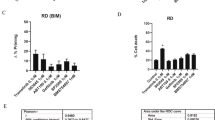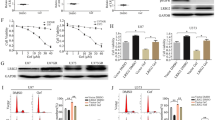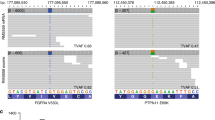Abstract
Agents targeting the insulin-like growth factor-1 receptor (IGF1R) are in clinical development, but, despite some initial success of single agents in sarcoma, response rates are low with brief durations. Thus, it is important to identify markers predictive of response, to understand mechanisms of resistance, and to explore combination therapies. In this study, we found that, although associated with PAX3-FKHR translocation, increased IGF1R level is an independent prognostic marker for worse overall survival, particularly in patients with PAX3-FKHR-positive rhabdomyosarcoma (RMS). IGF1R antibody-resistant RMS cells were generated using an in vivo model. Expression analysis indicated that IGFBP2 is both the most affected gene in the insulin-like growth factor (IGF) signaling pathway and the most significantly downregulated gene in the resistant lines, indicating that there is a strong selection to repress IGFBP2 expression in tumor cells resistant to IGF1R antibody. IGFBP2 is inhibitory to IGF1R phosphorylation and its signaling. Similar to antibodies to IGF1/2 or IGF2, the addition of exogenous IGFBP2 potentiates the activity of IGF1R antibody against the RMS cells, and it reverses the resistance to IGF1R antibody. In contrast to IGF1R, lower expression of IGFBP2 is associated with poorer overall survival, consistent with its inhibitory activity found in this study. Finally, blocking downstream Protein kinase B (AKT) activation with Phosphatidylinositide 3-kinases (PI3K)- or mammalian target of rapamycin (mTOR)-specific inhibitors significantly sensitized the resistant cells to the IGF1R antibody. These findings show that constitutive IGFBP2 downregulation may represent a novel mechanism for acquired resistance to IGF1R therapeutic antibody in vivo and suggest various drug combinations to enhance antibody activity and to overcome resistance.
This is a preview of subscription content, access via your institution
Access options
Subscribe to this journal
Receive 50 print issues and online access
$259.00 per year
only $5.18 per issue
Buy this article
- Purchase on Springer Link
- Instant access to full article PDF
Prices may be subject to local taxes which are calculated during checkout






Similar content being viewed by others
References
Clemmons DR . Modifying IGF1 activity: an approach to treat endocrine disorders, atherosclerosis and cancer. Nat Rev Drug Discov 2007; 6: 821–833.
Kurmasheva RT, Houghton PJ . IGF-I mediated survival pathways in normal and malignant cells. Biochimica et Biophysica Acta 2006; 1766: 1–22.
Pollak M . Insulin and insulin-like growth factor signalling in neoplasia. Nat Rev 2008; 8: 915–928.
Pollak M . The insulin and insulin-like growth factor receptor family in neoplasia: an update. Nat Rev 2012; 12: 159–169.
Zhang L, Zhou W, Velculescu VE, Kern SE, Hruban RH, Hamilton SR et al. Gene expression profiles in normal and cancer cells. Science (New York, NY) 1997; 276: 1268–1272.
Hendrickson AW, Haluska P . Resistance pathways relevant to insulin-like growth factor-1 receptor-targeted therapy. Curr Opin Investig Drugs 2009; 10: 1032–1040.
Yee D . Targeting insulin-like growth factor pathways. Br J Cancer 2006; 94: 465–468.
Yuen JS, Macaulay VM . Targeting the type 1 insulin-like growth factor receptor as a treatment for cancer. Expert Opin Ther Targets 2008; 12: 589–603.
Baserga R . The insulin-like growth factor-I receptor as a target for cancer therapy. Expert Opin Ther Targets 2005; 9: 753–768.
Olmos D, Basu B, de Bono JS . Targeting insulin-like growth factor signaling: rational combination strategies. Mol Cancer Ther 2010; 9: 2447–2449.
Gualberto A, Pollak M . Emerging role of insulin-like growth factor receptor inhibitors in oncology: early clinical trial results and future directions. Oncogene 2009; 28: 3009–3021.
Olmos D, Postel-Vinay S, Molife LR, Okuno SH, Schuetze SM, Paccagnella ML et al. Safety, pharmacokinetics, and preliminary activity of the anti-IGF-1R antibody figitumumab (CP-751,871) in patients with sarcoma and Ewing's sarcoma: a phase 1 expansion cohort study. Lancet Oncol 2010; 11: 129–135.
Tolcher AW, Sarantopoulos J, Patnaik A, Papadopoulos K, Lin CC, Rodon J et al. Phase I, pharmacokinetic, and pharmacodynamic study of AMG 479, a fully human monoclonal antibody to insulin-like growth factor receptor 1. J Clin Oncol 2009; 27: 5800–5807.
Pappo AS, Patel SR, Crowley J, Reinke DK, Kuenkele KP, Chawla SP et al. R1507, a monoclonal antibody to the insulin-like growth factor 1 receptor, in patients with recurrent or refractory Ewing sarcoma family of tumors: results of a phase II Sarcoma Alliance for Research through Collaboration study. J Clin Oncol 2011; 29: 4541–4547.
Reidy DL, Vakiani E, Fakih MG, Saif MW, Hecht JR, Goodman-Davis N et al. Randomized, phase II study of the insulin-like growth factor-1 receptor inhibitor IMC-A12, with or without cetuximab, in patients with cetuximab- or panitumumab-refractory metastatic colorectal cancer. J Clin Oncol 2010; 28: 4240–4246.
Ramalingam SS, Spigel DR, Chen D, Steins MB, Engelman JA, Schneider CP et al. Randomized phase II study of erlotinib in combination with placebo or R1507, a monoclonal antibody to insulin-like growth factor-1 receptor, for advanced-stage non-small-cell lung cancer. J Clin Oncol 2011; 29: 4574–4580.
Yee D . Insulin-like growth factor receptor inhibitors: baby or the bathwater? J Natl Cancer Inst 2012; 104: 975–981.
Helman LJ, Meltzer P . Mechanisms of sarcoma development. Nat Rev 2003; 3: 685–694.
El-Badry OM, Minniti C, Kohn EC, Houghton PJ, Daughaday WH, Helman LJ . Insulin-like growth factor II acts as an autocrine growth and motility factor in human rhabdomyosarcoma tumors. Cell Growth Differ 1990; 1: 325–331.
Cao L, Yu Y, Bilke S, Walker RL, Mayeenuddin LH, Azorsa DO et al. Genome-wide identification of PAX3-FKHR binding sites in rhabdomyosarcoma reveals candidate target genes important for development and cancer. Cancer Res 2010; 70: 6497–6508.
Crist WM, Anderson JR, Meza JL, Fryer C, Raney RB, Ruymann FB et al. Intergroup rhabdomyosarcoma study-IV: results for patients with nonmetastatic disease. J Clin Oncol 2001; 19: 3091–3102.
Petricoin EF 3rd, Espina V, Araujo RP, Midura B, Yeung C, Wan X et al. Phosphoprotein pathway mapping: Akt/mammalian target of rapamycin activation is negatively associated with childhood rhabdomyosarcoma survival. Cancer Res 2007; 67: 3431–3440.
Cao L, Yu Y, Darko I, Currier D, Mayeenuddin LH, Wan X et al. Addiction to elevated insulin-like growth factor I receptor and initial modulation of the AKT pathway define the responsiveness of rhabdomyosarcoma to the targeting antibody. Cancer Res 2008; 68: 8039–8048.
Mayeenuddin LH, Yu Y, Kang Z, Helman LJ, Cao L . Insulin-like growth factor 1 receptor antibody induces rhabdomyosarcoma cell death via a process involving AKT and Bcl-x(L). Oncogene 2010; 29: 6367–6377.
Davicioni E, Anderson MJ, Finckenstein FG, Lynch JC, Qualman SJ, Shimada H et al. Molecular classification of rhabdomyosarcoma--genotypic and phenotypic determinants of diagnosis: a report from the Children's Oncology Group. Am J Pathol 2009; 174: 550–564.
Davicioni E, Anderson JR, Buckley JD, Meyer WH, Triche TJ . Gene expression profiling for survival prediction in pediatric rhabdomyosarcomas: a report from the children's oncology group. J Clin Oncol 2010; 28: 1240–1246.
Straussman R, Morikawa T, Shee K, Barzily-Rokni M, Qian ZR, Du J et al. Tumour micro-environment elicits innate resistance to RAF inhibitors through HGF secretion. Nature 2012; 487: 500–504.
Bhat RV, Engber TM, Zhu Y, Miller MS, Contreras PC . Identification of insulin-like growth factor binding protein-2 as a biochemical surrogate marker for the in vivo effects of recombinant human insulin-like growth factor-1 in mice. J Pharmacol Exp Ther 1997; 281: 522–530.
Mehrian-Shai R, Chen CD, Shi T, Horvath S, Nelson SF, Reichardt JK et al. Insulin growth factor-binding protein 2 is a candidate biomarker for PTEN status and PI3K/Akt pathway activation in glioblastoma and prostate cancer. Proc Natl Acad Sci USA 2007; 104: 5563–5568.
Arai T, Busby W Jr, Clemmons DR . Binding of insulin-like growth factor (IGF) I or II to IGF-binding protein-2 enables it to bind to heparin and extracellular matrix. Endocrinology 1996; 137: 4571–4575.
Firth SM, Baxter RC . Cellular actions of the insulin-like growth factor binding proteins. Endocr Rev 2002; 23: 824–854.
Hoflich A, Lahm H, Blum W, Kolb H, Wolf E . Insulin-like growth factor-binding protein-2 inhibits proliferation of human embryonic kidney fibroblasts and of IGF-responsive colon carcinoma cell lines. FEBS Lett 1998; 434: 329–334.
Shariat SF, Lamb DJ, Kattan MW, Nguyen C, Kim J, Beck J et al. Association of preoperative plasma levels of insulin-like growth factor I and insulin-like growth factor binding proteins-2 and -3 with prostate cancer invasion, progression, and metastasis. J Clin Oncol 2002; 20: 833–841.
Wan X, Harkavy B, Shen N, Grohar P, Helman LJ . Rapamycin induces feedback activation of Akt signaling through an IGF-1R-dependent mechanism. Oncogene 2007; 26: 1932–1940.
Potratz JC, Saunders DN, Wai DH, Ng TL, McKinney SE, Carboni JM et al. Synthetic lethality screens reveal RPS6 and MST1R as modifiers of insulin-like growth factor-1 receptor inhibitor activity in childhood sarcomas. Cancer Res 2010; 70: 8770–8781.
Huang F, Hurlburt W, Greer A, Reeves KA, Hillerman S, Chang H et al. Differential mechanisms of acquired resistance to insulin-like growth factor-i receptor antibody therapy or to a small-molecule inhibitor, BMS-754807, in a human rhabdomyosarcoma model. Cancer Res 2010; 70: 7221–7231.
Garofalo C, Manara MC, Nicoletti G, Marino MT, Lollini PL, Astolfi A et al. Efficacy of and resistance to anti-IGF-1R therapies in Ewing's sarcoma is dependent on insulin receptor signaling. Oncogene 2011; 30: 2730–2740.
Hoeflich A, Wu M, Mohan S, Foll J, Wanke R, Froehlich T et al. Overexpression of insulin-like growth factor-binding protein-2 in transgenic mice reduces postnatal body weight gain. Endocrinology 1999; 140: 5488–5496.
Mathews LS, Hammer RE, Behringer RR, D'Ercole AJ, Bell GI, Brinster RL et al. Growth enhancement of transgenic mice expressing human insulin-like growth factor I. Endocrinology 1988; 123: 2827–2833.
Hedbacker K, Birsoy K, Wysocki RW, Asilmaz E, Ahima RS, Farooqi IS et al. Antidiabetic effects of IGFBP2, a leptin-regulated gene. Cell Metab 2010; 11: 11–22.
Martin JL, Baxter RC . Expression of insulin-like growth factor binding protein-2 by MCF-7 breast cancer cells is regulated through the phosphatidylinositol 3-kinase/AKT/mammalian target of rapamycin pathway. Endocrinology 2007; 148: 2532–2541.
Hoeflich A, Reisinger R, Lahm H, Kiess W, Blum WF, Kolb HJ et al. Insulin-like growth factor-binding protein 2 in tumorigenesis: protector or promoter? Cancer Res 2001; 61: 8601–8610.
Moore LM, Holmes KM, Smith SM, Wu Y, Tchougounova E, Uhrbom L et al. IGFBP2 is a candidate biomarker for Ink4a-Arf status and a therapeutic target for high-grade gliomas. Proc Natl Acad Sci USA 2009; 106: 16675–16679.
Hochberg Y, Benjamini Y . More powerful procedures for multiple significance testing. Stat Med 1990; 9: 811–818.
Acknowledgements
We are very grateful to Merck and Roche for providing h7C10 and R1507 antibodies to IGF1R, Dimiter Dimitrov for antibodies against IGF2 and IGF1/2, Yuxin Zhang for assistance in Cox regression analysis, Sven Bilke for advice on statistical analysis, Javed Kahn for help with RMS patient expression database analysis and minimization of P value for cutoff selection, Arnulfo Mendoza for animal study, David Petersen for pyrosequencing and Jennifer Crawford for reading the manuscript.
This research was supported by the Intramural Research Program of the US National Cancer Institute (NCI). This project was also funded in part with federal funds from the NCI, NIH, under contract N01-CO-12400.
Author information
Authors and Affiliations
Corresponding author
Ethics declarations
Competing interests
The authors declare no conflict of interest.
Additional information
Supplementary Information accompanies this paper on the Oncogene website
Supplementary information
Rights and permissions
About this article
Cite this article
Kang, Z., Yu, Y., Zhu, Y. et al. Downregulation of IGFBP2 is associated with resistance to IGF1R therapy in rhabdomyosarcoma. Oncogene 33, 5697–5705 (2014). https://doi.org/10.1038/onc.2013.509
Received:
Revised:
Accepted:
Published:
Issue Date:
DOI: https://doi.org/10.1038/onc.2013.509
Keywords
This article is cited by
-
Targeting the undruggable: exploiting neomorphic features of fusion oncoproteins in childhood sarcomas for innovative therapies
Cancer and Metastasis Reviews (2019)
-
IGF-binding protein 2 is a candidate target of therapeutic potential in cancer
Tumor Biology (2016)



